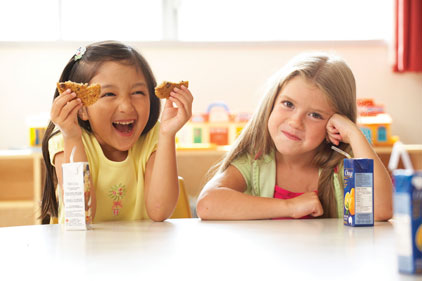The result "demonstrates the need for adults to make sure they sit and eat with children and help to support children to recognize their hunger and fullness," said Samantha Ramsay, an assistant professor of Foods and Nutrition at the University of Idaho, who was not involved in the research.
Ramsay added, the findings do not mean that children should not serve themselves at mealtimes.
Major nutritional and medical organizations have endorsed the practice of letting kids help themselves to food out of communal dishes.
There are a number of benefits to so-called "family style" service, including the development of social skills, such as taking turns, practicing fine motor skills, such as working a fork or spoon, and learning independence, Ramsay said.
Another presumed benefit is that kids will not overeat. Past research has found that children eat more when their meal portion is larger.
"So the thought (was) that allowing children to self-select (food portions), as opposed to being served portions, which tend to be larger than age-appropriate, children may potentially consume more in line with what they actually need," said Jennifer Savage Williams, associate director of the Center for Childhood Obesity Research at Penn State University the new study's lead author.
Savage Williams and her colleagues wanted to test whether that was the case, so they experimented by giving kids macaroni and cheese, either already dished out or from a self-serve bowl.
The study included 63 three- to five-year-olds. During the lunchtime in which the researchers chose the serving size, the kids were given a large, 400g serving -- close to a pound -- of macaroni and cheese.
During another lunch intended to mimic family-style eating, the kids were allowed to serve themselves from a bowl that contained 400g of macaroni.
In both cases, the kids ate about the same amount of macaroni and cheese, roughly 200g.
"Contrary to expectations, total energy consumed at the meal did not differ on the basis of whether children served themselves or were served a large plated entreé," the researchers write in their report in the American Journal of Clinical Nutrition.
In other words, letting kids serve themselves was not an effective way to ensure they did not overeat.
Savage Williams said family-style meals might still have benefits for kids' development.
"Self-serving may be good, but it's important to have some guidance and rules about how to self-select appropriate portion sizes," she said.
As part of the same study, the team also offered kids pre-plated macaroni and cheese meals of different sizes, ranging from 100-400g.
The researchers found that the kids who ate more when they were offered more were also more likely to spoon themselves bigger portions of macaroni when they were allowed to serve themselves.
Ramsay said it is likely that these children have not learned how to tune in to their "internal fullness cues" and instead they respond to how much food is in front of them.
"If adults are giving children larger portion sizes, this study (suggests) that children will continue to serve themselves larger portions," Ramsay told Reuters Health.
Savage Williams said it is important for parents and teachers to help children know to stop eating when they're full, rather than to finish all the food in front of them and potentially overeat.
"If you're going to allow children to self-select (food portions), it may be important for some children to give guidance in how to do this healthfully," she said.
From the June 11, 2012, Prepared Foods’ Daily News
